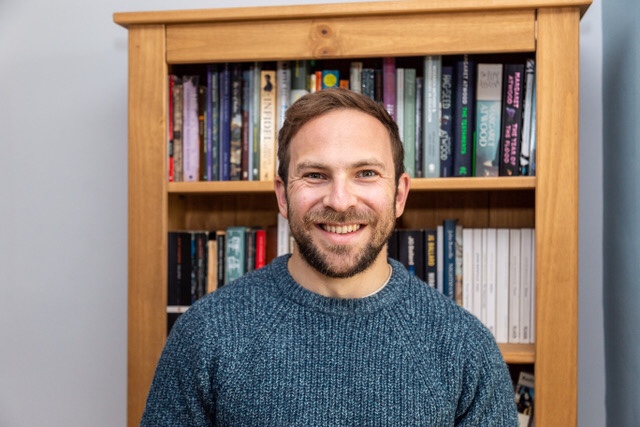Patricia Lockwood’s No One Is Talking About This (Bloomsbury, 2021) won last year’s Swansea University Dylan Thomas Prize, and was cited especially for its depiction of the Internet. In the book, the ‘portal’ is a virtual world that can provide access to ‘everywhere’, but is a largely desensitised space; it is where the protagonist spends most of her time.
Nevertheless, that desensitisation is part of its appeal, as it becomes a space where humour and irony reign, and it becomes a less serious space than the ‘clear blue place’ where a Trumpian ‘dictator’ reigns.
The balance between the portal and the clear blue shifts, however, in Part Two, when the protagonist learns about her unborn niece’s genetic disorder that will eventually kill her. Most of Part Two describes the protagonist’s time spent with her niece as we witness her living and, finally, dying.
Amidst all this, a vein of preemptive and post hoc archiving takes place, all part of the protagonist’s grieving process. But the archive doesn’t start with grief: the archive becomes part of the process of mourning only later in the text.
The first example of the archive begins at the beginning, with genetic sequencing itself. ‘A few years ago her husband had bought her a DNA test,’ we read:
She saw her DNA streaming backward from her body like a timeline, richly peopled with the faces of distant cousins behind bars, and she was somehow the one who had put them there, by moving the clock another age past then, by being born at all.
Patricia Lockwood, No One Is Talking About This (London: Bloomsbury, 2021), p. 111
This passage does double work. Not only does it recognise that DNA is an archival system itself—containing elements of all predecessors within a closed biological system—but that the protagonist is also the archivist who is lining up the predecessors as predecessors. The archivist–protagonist is in charge of time.
The following paragraph introduces an apparently tangential character to the story, ‘a man who stood and laughed in the voice of his great-grandfather for five full minutes[. … H]e had explained earlier that his ancestors were always with him when he performed’ (Lockwood, p. 111). As the paragraph continues, the protagonist realises that this is true for her, also, but that she also ‘saw that ancestors weren’t just behind, they were the ones who were to come’ (p. 112). This proleptic irony, pointing us towards the niece who is born and dies in the pages after this moment, also teaches us more about the archivist’s control of time: it is possible to archive the future as much as the past.
Jacques Derrida wrote about the archons, the people who looked after the archives. In a 1995 essay, ‘Archive Fever: A Freudian impression’, he wrote that
The archons are first of all the documents’ guardians. They do not only ensure the physical security of what is deposited[. …] They have the power to interpret the archives. Entrusted to such archons, these documents in effect state the law: they recall the law and call on or impose the law. To be guarded thus, in the jurisdiction of this stating the law, they needed at once a guardian and a localization.
Jacques Derrida, ‘Archive Fever: A Freudian impression’, Diacritics, 1995 (25.2), 9–63 (10)
Derrida’s turn to the legal or juridical realm is necessary in his argument, as he traces the history of the word ‘archive’ to a legal instruction in ancient Greece. For my purposes here, it’s enough to note that what is archived takes on the form of law that is necessarily protected from degradation.
DNA, that instruction manual to cells as they reproduce, is such a law. It created the protagonist, and instructed/will instruct the creation of ancestors, both those in the past and the future.
When grieving, the protagonist herself becomes an archive of another sort, and on one occasion it takes place on the stage during a public lecture, not unlike how the man who laughed like his grandfather staged his archived recollection. This time, however, it is a sad archiving, and one that protects the item archived from degradation, but does not make it public. The protagonist is giving a lecture at the British Museum, and she thinks ‘about the 24-hour NICU [Neonatal Intensive Care Unit] badge in her coat pocket, that she kept there to remind herself she had once been a citizen of necessity’ (Lockwood, p. 205). The protagonist has archived the badge—kept it, protected it—and accesses it during the lecture in order to receive its instruction for her behaviour and role in society: a caring aunt to her ill niece.
But that role no longer pertains. The archive’s instructions are anachronistic. And yet this is mourning, all part of the process of grieving her niece’s death.
So also is the ‘meticulous documentation of the baby’s final days in her photoroll’ on her phone (Lockwood, p. 203), and the photoroll’s accessibility: ‘The pictures were always with her’ (p. 204). To access the archive whenever desired—this time a digital archive—is the privilege of the archon, the protagonist, who has carefully curated and stored these ‘documents’ on her phone.
Might we therefore extend the ‘work of mourning’ in the age of the digital and virtual—in the age of Lockwood’s ‘portal’—to include the following: To construct one’s ancestry in the future?
Is this just a description of the archive itself? Does it find an origin in the human condition (i.e. in DNA)? Or is there something more central to this digital archive that I have missed from No One Is Talking About This?
One potential answer: I have written elsewhere about the way in which Irish poet Seamus Heaney acts as an archaeologist in unearthing pasts buried deep in the land of Ireland, but then acts as a capital-H Historian[1] by archiving that past in his poetry. For instance, ‘The Grauballe Man’ (1975) has a ‘cured wound’ that ‘opens inward to a dark / elderberry place’.[2] By reinserting—or burying—the Grauballe Man in his poem, Heaney transposes him from underneath the surface of the bog to the contents of the poem. This is Heaney as Historian.
Is Lockwood also a Historian? Is No One Ever Talks About This itself a novel of grief that archives the story of the protagonist’s niece whose own DNA archive is programmed to last only a few short months? Perhaps it is a novel–archive that can be accessed publicly by its readership in order to sustain the archival instructions from the niece, as recorded in the Acknowledgements: ‘You were not here to teach us, but we did learn.’ (Lockwood, p. 210)
[1] ‘To give a unifying name to this figure who achieves both the archaeological and archiving processes, let me call him a Historian. Not an amorphous figure who “writes histories” or narrativises history into chronological order (as I accuse the early modern English of doing), but instead a Historian according to Carolyn Steedman’s analysis. In Dust (2001), Steedman updates Freud, Foucault, and Derrida, and relates her own experiences as a social historian of entering the archive and writing about what she finds there. Ultimately, she concludes, “history gives a habitation and a name to all the fragments” (2001: 149).’ (Nicholas Taylor-Collins, Shakespeare, memory, and modern Irish literature (Manchester: Manchester UP: 2022), p. 258.
[2] Seamus Heaney, North (London: Faber and Faber, 2001 [1975]), ll. 22–4.


Leave a Reply